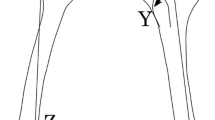Abstract
Purpose
Besides the long-leg standing X-ray film focusing on static standing mechanical alignment of the lower extremity, dynamic alignment from full extension to 90° flexion after total knee arthroplasty (TKA) is rarely mentioned. Computer-assisted surgical technology enables surgeons to measure and assess knee behaviour during surgery. This study was designed to analyse the influences of femoral rotation on dynamic alignment of the lower extremity in TKA.
Methods
Seventy-six consecutive patients with end-stage knee osteoarthritis were enrolled. External rotation osteotomy of the distal femur during TKA was completed according to the pre-operative external rotation angle (ERA), intra-operative transepicondylar axis (TEA) and anteroposterior (AP) line. Passive dynamic alignment of the lower extremity during knee flexion was recorded. The variation trend of hip–knee–ankle (HKA) alignment and the influences of femoral external rotation osteotomy were analysed.
Results
Postoperative deviation of HKA alignment from 0° to 90° flexion was associated with the rotational alignment of the femoral component (r = −0.769, p < 0.001). Variation trend of HKA alignment during knee flexion tended to be varus, valgus and neutral according to the selected angle of external rotation osteotomy of the distal femur.
Conclusion
External rotation osteotomy of the distal femur played a crucial role in determining dynamic HKA alignment in TKA.







Similar content being viewed by others
References
Rand JA, Coventry MB (1988) Ten-year evaluation of geometric total knee arthroplasty. Clin Orthop 232:168–173
Jeffrey RS, Morris RW, Denham RA (1991) Coronal alignment after total knee replacement. J Bone Joint Surg 73:709–714
Bäthis H, Perlick L, Tingart M (2004) Alignment in total knee arthroplasty. A comparison of computer-assisted surgery with the conventional technique. J Bone Joint Surg 86:682–687
Jenny JY, Boeri C (2001) Implantation d’une prothèse totale de genou assistée par ordinateur. Rev Chir Orthop 87:645–652
Sparmann M, Wolke B, Czupalla H (2003) Positioning of total knee arthroplasty with and without navigation sup-port. A prospective randomised study. J Bone Joint Surg 85:830–835
Stindel E, Briard JL, Merloz P (2002) Bone morphing: 3D morphological data for total knee arthroplasty. Comput Aided Surg 7:156–168
Zorman D, Etuin P, Jennart H (2005) Computer-assisted total knee arthroplasty: comparative results in a preliminary series of 72 cases. Acta Orthop Belg 71:696–702
Daniilidis K, Tibesku CO (2013) Frontal plane alignment after total knee arthroplasty using patient-specific instruments. Int Orthop 37:45–50. doi:10.1007/s00264-012-1732-1. Epub 2012 Dec 12
Picard F, Gregori A, Dean F et al (2006) Computer-assisted dynamic total knee arthroplasty using Whiteside’s line for alignment. Orthopedics 29:104–7
Anouchi YS, Whiteside LA, Kaiser AD et al (1993) The effects of axial rotational alignment of the femoral component on knee stability and patellar tracking in total knee arthroplasty demonstrated on autopsy specimens. Clin Orthop 287:170
Clayton ML, Thirupathi R (1982) Patellar complica-tions after total condylar arthroplasty. Clin Orthop Relat Res 170:152–155
Nagamine R, White SE, McCarthy DS et al (1995) Effect of rotational malposition of the femoral component on knee stability kinematics after total knee arthroplasty. J Arthroplasty 10:265–70
Engh GA (2000) Orienting the femoral component at total knee arthroplasty. Am J Knee Surg 13:162–165
Mayr HO, Reinhold M, Hube R et al (2014) Rotational laxity and collateral ligament laxity following total knee arthroplasty with rotating platform. Int Orthop 38:1379–86. doi:10.1007/s00264-014-2308-z. Epub 2014 Mar 7
Olcott CW, Scott RD (2000) A comparison of 4 intraoperative methods to determine femoral component rotation during total knee arthroplasty. J Arthroplasty 15:22–6
Jerosch J, Peuker E, Philipps B et al (2002) Interindividual reproducibility in perioperative rotational alignment of femoral components in knee prosthetic surgery using the transepi-condylar axis. Knee Surg Sports Traumatol Arthrosc 10:194–197
Jenny JY, Boeri C (2004) Low reproducibility of the intra-operative measurement of the tran-sepicondylar axis during total knee replacement. Acta Orthop Scand 75:74–77
Galaud B, Beaufils P, Michaut M et al (2008) Distal femoral torsion: comparison of CT scan and intra operative navigation measurements during total knee arthroplasty. A report of 70 cases. Rev Chir Orthop Reparatrice Appar Mot 94:573–9
Fulkerson JP, Schutzer SF, Ramsby GR (1987) Computerized tomography of the patellofemoral joint before and after lateral release or realignment. Arthrosc 3:19–24
Aglietti P, Insall JN, Cerulli G (1983) Patellar pain and incongruence: I. Measurements of incongruence. Clin Orthop Relat Res 176:217–224
Boisgard S, Moreau PE, Descamps S (2003) Computed tomographic study of the posterior condylar angle in arthritic knees: its use in the rotational positioning of the femoral implant of total knee prostheses. Surg Radiol Anat 25:330–334
Brossmann J, Muhle C, Schröder C et al (1993) Patellar tracking patterns during active and passive knee extension: evolution with motion-triggered Cine MR imaging. Radiology 187:205–212
Winemaker MJ (2002) Perfect balance in total knee arthroplasty: the elusive compromise. J Arthroplasty 17:2–10
Mihalko WM, Saleh KJ, Krackow KA et al (2009) Soft-tissue balancing during total knee arthroplasty in the varus knee. J Am Acad Orthop Surg 17:766–74
Sharkey PF, Hozack WJ, Rothman RH (2002) Insall award paper. Why are total knee arthroplasties failing today? Clin Orthop Relat Res 404:7–13
Gustke K (2012) Use of smart trials for soft-tissue balancing in total knee replacement surgery. J Bone Joint Surg (Br) 94:147–50
Author information
Authors and Affiliations
Corresponding author
Rights and permissions
About this article
Cite this article
Zhao, Z., Wang, W., Wang, S. et al. Femoral rotation influences dynamic alignment of the lower extremity in total knee arthroplasty. International Orthopaedics (SICOT) 39, 55–60 (2015). https://doi.org/10.1007/s00264-014-2484-x
Received:
Accepted:
Published:
Issue Date:
DOI: https://doi.org/10.1007/s00264-014-2484-x




